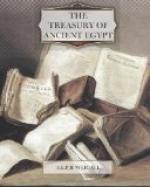This seems to have impressed the queen, for she ordered the mob to stand on one side, and to Wenamon she said, “Pass the night ...”
Here the torn writing comes to an abrupt end, and the remainder of Wenamon’s adventures are for ever lost amidst the dust of El Hibeh. One may suppose that Hetebe took the Egyptian under her protection, and that ultimately he arrived once more in Egypt, whither Zakar-Baal had perhaps already sent the timber. Returning to his native town, it seems that Wenamon wrote his report, which for some reason or other was never despatched to the High Priest. Perhaps the envoy was himself sent for, and thus his report was rendered useless; or perhaps our text is one of several copies.
There can be no question that he was a writer of great power, and this tale of his adventures must be regarded as one of the jewels of the ancient Egyptian language. The brief description of the Prince of Byblos, seated with his back to the window, while the waves beat against the wall below, brings vividly before one that far-off scene, and reveals a lightness of touch most unusual in writers of that time. There is surely, too, an appreciation of a delicate form of humour observable in his account of some of his dealings with the prince. It is appalling to think that the peasants who found this roll of papyrus might have used it as fuel for their evening fire; and that, had not a drifting rumour of the value of such articles reached their village, this little tale of old Egypt and the long-lost Kingdoms of the Sea would have gone up to empty heaven in a puff of smoke.
CHAPTER VI.
THE STORY OF THE SHIPWRECKED SAILOR.
When the early Spanish explorers led their expeditions to Florida, it was their intention to find the Fountain of Perpetual Youth, tales of its potent waters having reached Peter Martyr as early as 1511. This desire to discover the things pertaining to Fairyland has been, throughout history, one of the most fertile sources of adventure. From the days when the archaic Egyptians penetrated into the regions south of the Cataracts, where they believed that the inhabitants were other than human, and into Pount, the “Land of the Ghosts,” the hope of Fairyland has led men to search the face of the earth and to penetrate into its unknown places. It has been the theme of countless stories: it has supplied material for innumerable songs.
And in spite of the circumambulations of science about us, in spite of the hardening of all the tissues of our imagination, in spite of the phenomenal development of the commonplace, this desire for a glimpse of the miraculous is still set deeply in our hearts. The old quest of Fairyland is as active now as ever it was. We still presume, in our unworthiness, to pass the barriers, and to walk upon those paths which lead to the enchanted forests and through them to the city of the Moon. At any moment we are ready to set forth, like Arthur’s knights, in search of the Holy Grail.




